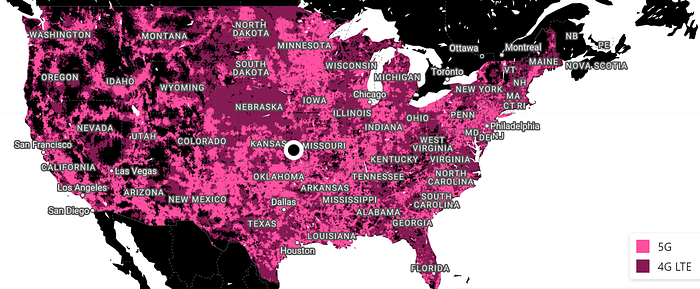5G
What is it? And, why are people excited?
There is a lot of hype around 5G (and a lot of misinformation). If you google 5G, as I did recently, you will find everything from paid ads from telecom providers, to articles about those same telecom providers facing legal action for misleading ads, to articles about the transformation this will drive in our industries, to studies defending the “lack of health effects”. But, what actually is 5G? What technology underlies 5G? What is holding 5G back? And, where will its effects be seen first?
What is 5G?
At the most basic level, 5G is a blanket name for a set of technology / standards that comprise the 5th generation of wireless. You are probably familiar with previous generations of wireless, but you can see the rough performance specs compared below.

Just as 4G unleashed the potential of mobile apps, 5G is designed to enable the Internet of Things. It does this by meeting three performance criteria.
1) Enhanced Mobile Broadband (eMBB): Increased speeds at which devices can download data. Theoretically, max download speeds are constrained by the bandwidth allocated to a task. However, existing technology does not use bandwidth super efficiently. 5G will improve on this, leveraging certain technologies to allow more information to reach devices within existing bandwidth constraints.
2) Ultra-Reliable Low Latency Communications (uRLLC): Latency refers to the time it takes for a receiver to receive and process a request. 5G technology and standards will streamline this process, lowering latency.
3) Massive Machine Type Communications (mMTC): This will allow many ‘low usage’ devices (IoT) to access networks in efficient ways.
How can 5G meet these criteria?
These improvements are enabled by a set of technologies that allow more efficient use of spectrum and flexibility in how each device uses the network.
Massive MIMO + “Beamforming”: Multiple-Input, Multiple-Output antennas basically pack many antennas onto a base station. Each antenna then uses a technique called ‘beamforming’ to send data directly (and efficiently) to a device, versus sending the data out in all directions (which is how a traditional wireless signal would propagate). This precision allows the network to use the same bandwidth to transmit data to multiple users simultaneously, by modulating the intensity of the signal in the direction of each user — which is great for packing more devices onto the network! It is also much better at tracking devices on the move, providing increased reliability of the cellular signal.
Carrier Aggregation: The ability of a device to receive data from multiple “bands” simultaneously to increase total bandwidth and coverage. 5G can support combining 16 bands at once, while 4G can only do 2–5.
Network Slicing: Cellular networks have historically been optimized for phones. However, there are now many other devices that access cellular networks, including IoT devices. Network slicing allows network operators to create ‘virtualized’ networks with specific functionality and resources to support the needs of a specific use case. So, for example, one slice could be optimized for mobile phones, one for basic IoT, one for ‘mission critical IoT’, etc.
Configured Grants[1]: There are two ways for a device to access a network in 4G: continuously or sporadically. For low usage devices, continuous connection can be energy inefficient, but each time the device requests access, it must then await approval, which takes time and increases latency. In 5G, the standard is written so multiple low-usage devices can continuously use the same network resources, each accessing those resources directly as needed. This will eliminate the approval delay, without reducing efficiency.
This list is not exhaustive — there are more technology and standards written into 5G. But, it’s a good start for now!
That all sounds great — so where is 5G?
Well, in the US, most 5G spectrum today is in the “mmWave” section of the spectrum (24K — 52K Hz). This high frequency spectrum range has a ton of bandwidth, but it has one major limitation: mmWave has low dispersion. Its waves are easily blocked by buildings, trees, cars, people — just about anything. Take a look at the below chart, comparing the dispersion signal of a mmWave signal to a ‘mid-band’ signal (<6K Hz) in Los Angeles.

Images from a presentation to the DoD in 2019
So, building network coverage using mmWave bandwidth requires installing many “small cells” — small cell towers that can be installed on traffic lights, power line poles, etc. However, small cells are expensive (~$30K per cell, including average licensing fees) and generally are subject to strict approval rules from cities. It can take 18–24 months for a city to approve a small cell installation, although many states have passed laws streamlining the process. Still, ubiquitous coverage will not happen overnight.
Okay, so what comes next?
The world is still early in the 5G story. With current spectrum allocation in the US, 5G roll-outs will be primarily focused on cities, where the density of consumers can make the cost of small cell installation worthwhile.
The exception is T-Mobile, which as a result of its Sprint acquisition, is using ‘mid-band’ technology to roll out 5G. As a result, although they do not have the download speeds associated with mmWave spectrum, they have achieved pretty broad coverage (see the painfully bright chart from their website below).

Additionally, the US just announced that they will be auctioning off more mid-band spectrum for 5G use. Still, this auction will take not take place until late 2021, with any services not starting until 2022.
However, in many ways, 5G is an enterprise technology, not a consumer one. Sure, consumers will be able to download videos faster, but 5G is most transformative for the IoT ecosystem. And, IoT devices outside of big cities may not see the benefit in the near term.
So, where will 5G have the biggest impact?
In thinking about the impacts of 5G, it is useful to remember the benefits of 5G — continuous ‘real-time’ connectivity, efficient power usage, and ability to support many devices simultaneously. So, with that in mind, there are a few applications we are excited about.
1) Mobility Applications: 5G, in the near term will remain more expensive than other forms of connectivity, like WiFi and Bluetooth, or even 4G LTE. But, these technologies have different use cases. WiFi works best for stationary indoor applications in an ‘owned’ area, like a home or a business (where I can control my signal strength), while Bluetooth works best over short distances. For machines that need high quality, very fast connectivity as they move, 5G will be a key enabling technology. This includes everything from autonomous vehicles, to delivery drones, to city buses and trains.
2) Ultra-Low Power Applications: One of the benefits of 5G is its energy efficiency advantage over 4G — Verizon estimates a 90% reduction in energy consumption[2]. So, for devices that operate in remote or hard to reach environments, 5G could extend the maintenance cycle of a device by 10x. For example, think of a device that tracks leaks in a water main, or one that monitors the composition of sewage (similar to what Kansas City has been doing to modernize its sewer system).
3) Dense Applications (Smart Cities): There are many smart city applications that are already being implemented today but can be further improved with 5G. Given the ability to handle numerous devices, cities can deploy much more extensive sensor coverage without overwhelming the cellular network, to optimize things like electric grid usage, traffic, and safety.
So, I see significant innovation coming over the next five years, particularly in urban environments, as 5G networks improve coverage and 5G chip prices continue to drop. These will not be “5G” start-ups, but rather they will be ideas that might exist in a limited fashion today, that will be able to drive much more value with 5G infrastructure.
[1] https://www.edn.com/how-5g-reduces-data-transmission-latency/
[2] https://www.verizonwireless.com/business/articles/business/5g-network-performance-attributes/









